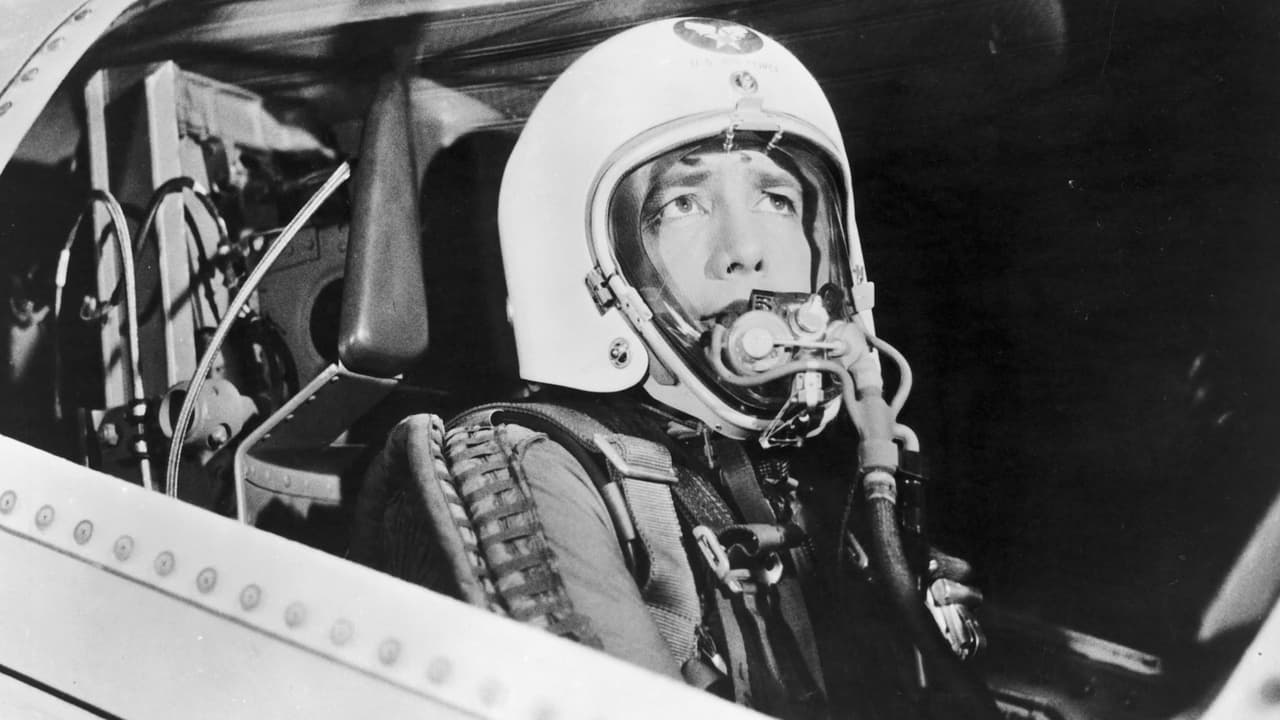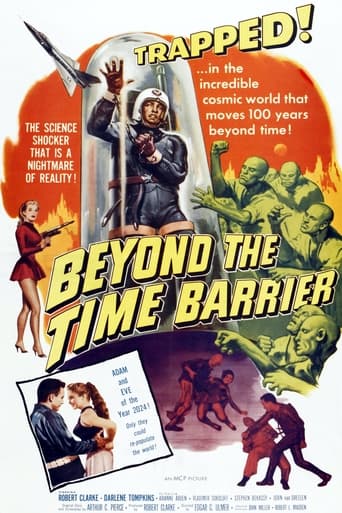

the leading man is my tpye
... View MoreI gave it a 7.5 out of 10
... View MoreGood concept, poorly executed.
... View MoreWhile it doesn't offer any answers, it both thrills and makes you think.
... View More"Beyond the Time Barrier" is the type of late 50s/early 60s Sci-Fi film of which you know, after approximately five minutes already, that it could have been a fantastic contemporary genre highlight if only the cast and crew didn't have to work with such a minimalist budget! Most of the conceptual ideas are really great and well- elaborated, but the cheap looking set pieces and the pitiable special effects have an immensely restraining impact on the overall plausibility and entertainment value. In case you serve an ambitious plot that is dealing with time-traveling and largely takes place in a futuristic dystopia, you can't afford to use paper made spaceships or drawings of the metropolis and you most certainly cannot speak of horribly deformed mutants the entire time without properly showing their faces! So, in an attempt to cover up for the budgetary weakness, Edgar G. Ulmer does what every experienced veteran director would do: replace the action sequences with endless intellectual speeches and complicated time warp theories as much as you can! In 1960, Major William Ellison has the honor and privilege to test-fly a brand new and hi-tech type of army fighter plane. The speed of the aircraft is even a little too successful, as Ellison breaks through the time barrier and ends up in the year 2024. It takes quite a while before our Major properly realizes that he fast- forwarded 64 years into the future, and the technical details are explained to him by three other scientists that went through the same experience. By the way, I didn't understand one iota about those time-traveling theories, but I also figure that incomprehensible speeches are a mandatory aspect of 50s Sci-Fi Ellison immediately gets confronted with the terrible state of our planet and civilization in the year 2024. Apparently an all- devastating kind of cosmic plague made the entire world population sterile (the last child was born more 20 years ago) and gradually transforms the remaining survivors into mutants. There's also good news, however, as the last fertile woman on earth is a beautiful princess and she has chosen him to re-populate the planet! She – Trirene – is a deaf-mute with telekinetic powers and she can read Ellison's thoughts, which results in at least one (unintentionally?) hilarious sequence: "I know you can read my mind . Although right now I probably wished you couldn't" and then he gets slapped in the face! Admittedly "Beyond the Time Barrier" principally got made to cash in on the tremendous success of H.G. Wells' "The Time Machine" and also borrows many elements from Fritz Lang's "Metropolis", but it's an engaging and occasionally suspenseful tale. I even like to think that some nifty ideas from this film were copied years later in massive Hollywood productions (for example the sterility in "Children of Men"), although I'm probably mistaken.
... View MoreThe basic idea behind "Beyond the Time Barrier" isn't bad--it's just painfully obvious it was a super-low budget film. Too many set and script problems lingered that would have been worked out if the film makers had more than $45 to make the entire film. Despite this, the film does have two minor stars in it--Victor Sokoloff (a familiar face but a name you'll not readily recognize) and Robert Clark (who made a few sci-fi films and guest starred on TV shows like "Dragnet").The film is set in 1960. Clark is a Major in the Air Force and is flying a sub-orbital high altitude experimental flight. However, something odd happens and he's somehow transported 64 years into the future! And, unfortunately, the future completely sucks! It seems some plague killed most of the folks on Earth and left most of the rest as either mutants or total jerks! So, Clark has to somehow get back to his time to alert the folks on Earth. Can he do it? And, is there any way they'll believe him? And, will the complete and total jerks of the future even let him attempt this...after all, they ARE jerks! Overall, despite the crappy sets, I could recommend this to lovers of cheesy sci-fi. That's because the basic story isn't bad at all and it ended very well. On the other hand, be forewarned--it is cheap--REALLY cheap. The worst are the 'mutants' kept in prison. The ones near the top of the steps and those down inside the pit are OBVIOUSLY from different movies--and look NOTHING like each other!! The stairs ones are guys (no ladies?) wearing the absolute worst skin-head wigs I've ever seen! They are hilariously dumb. But, the folks living down in the pit look almost like extras from "Island of Lost Souls"--all covered in hair and looking a bit primordial!! Duh! So, if you can ignore the dumb parts, it's not bad...but still uneven.
... View MoreHere we go again! Major William Allison (Robert Clarke), our reluctant hero (Is there any other kind in this type of cinema?), has reached the speed of light in his sonic-busting jet, shattered it, and has found himself on the other side of the time barrier. No small feat. But when he returns to his home base of operations, he finds it lifeless and ravaged by time. Little would he know how ravaged and by how much time. Also, as he will later find out, a victim of a nuclear conflict. Whew! That's a lot to swallow in one afternoon. Major Allison has definitely seen better days. He is then zapped by a paralyzing ray (a lavish matte shot) emanating from a futuristic metropolis and nestled next to a city in smithereens. Major Allison now finds himself hauled off--against his will--to an underground lodging facility. The Citadel, as the locals refer to it, is inhabited by a race of humans cowering in fear from the radiation scarred mutants living above. The city has a triangle motif everywhere: doorways, hallways, video screens, etc. Labeled a "'scape," an outsider, by both the mutants and tunnel dwellers, Allison finds solace and comfort in the arms of the super lovely Darlene Thomkins. She plays a deaf mute who remains the only fertile female within screaming distance. Or so says her father, "The Supreme." We know where this is going--don't we? Allison meets several other "'scapes," scientists from his future, who have other ideas on how he should spend his time: less time with the horny chick and more time seeking a return to his own time. Scientists are never any fun. In the end, the film is a cautionary tale against the arms race. I think it works well enough to be called a minor classic. If not--the mute female in the short skirt should suffice. For now.
... View MoreIf you considering this title, you are probably towards the end of your journey to see all that the 'fifties' sci-fi genre has to offer, and rightly so.BTTB is a Z Grade affair all the way. While the story concept and sets are intriguing enough, the lame acting, lack of action, and static camera work make this one almost unwatchable. Ulmer's high point for low budget was Detour. This is nowhere near Detour.For bottom of the barrel fifties sci-fi, I would definitely recommend War of the Satellites, Satellite in the Sky, Night the World Exploded, Phantom From Space or Mutiny in Outer Space long before I would recommend Beyond the Time barrier. It's not terribly bad, just terribly unengaging....
... View More